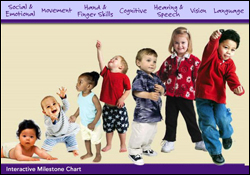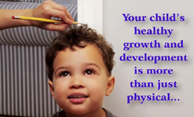CDC Features
Current Features
Detect Autism Early. Interactive Tools for Parents.

Do you know all the ways you should measure your child's growth? We naturally think of height and weight, but from birth to 5 years, your child should reach milestones in how he plays, learns, speaks and acts. A delay in any of these areas could be a sign of a developmental problem, even autism. The good news is, the earlier it's recognized the more you can do to help your child reach her full potential.
CDC's "Learn the Signs. Act Early." campaign has two interactive tools to help you watch for and record your child's developmental milestones. Remember that babies and children develop at their own pace, so it's impossible to tell exactly when yours will learn a given skill. The developmental milestones will give you a general idea, but don't be alarmed if your child takes a slightly different course.
Interactive Milestones Chart
This Interactive Milestones Chart allows you to view how a developmental milestone category (such as language) changes as a child grows. Developmental milestones are grouped under 7 categories:

• Social and emotional
• Movement
• Hand and finger skills
• Cognitive
• Hearing and speech
• Vision
• Language
To try out this tool, go the Interactive Milestones Chart page and click on a milestone category at the top.
Interactive Milestones Checklist

This Interactive Milestones Checklist is a great way to record the milestones your child is reaching for a baby book or as a way to share your child's development with the doctor or nurse at the next checkup.
To try out this tool, go to the Interactive Milestones Checklist page.
• Select the age of your child and click "Go."
• Type in your child's name, age, and today's date.
• Check off the milestones your child has already achieved.
• Click "Create Checklist."
• Print and/or email this record.
• Ask a relative, friend, or daycare provider to tell you what they see your child doing.
• Print off a blank checklist or send it to them via email.
What Can I Do if I Suspect a Problem with My Child's Development?
If you or your doctor think there could be a problem, ask for a referral to see a developmental pediatrician or other specialist, and contact your local early intervention agency (for children under 3) or public school (for children 3 and older). To find out who to speak to in your area, you can contact the National Dissemination Center for Children with Disabilities by logging on to http://www.nichcy.org* or calling 1-800-695-0285. In addition, the CDC has links to information for families on their Autism Information Center page.
Right now, the main research-based treatment for autism spectrum disorders is intensive structured teaching of skills, often called behavioral intervention. It is very important to begin this intervention as early as possible in order to help your child reach his or her full potential. Acting early can make a real difference!
For More Information
Page last updated: April 21, 2008
Content Source: National Center on Birth Defects and Developmental Disabilities
Content owner: National Center for Health Marketing
URL for this page: www.cdc.gov/Features/DetectAutismTools
*Links to non-federal organizations are provided solely as a service to our users. These links do not constitute an endorsement of these organizations or their programs by CDC or the federal government, and none should be inferred. CDC is not responsible for the content of the individual organization Web pages found at these links



